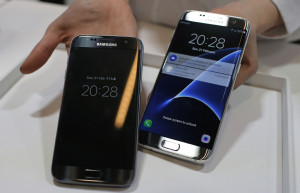
By: Grant Stoner

By week’s end, the Samsung Galaxy S7 and S7 Edge will become available to the masses.
According to Samsung’s website, the new features such as enhanced cameras, which allow for “a fast autofocus for less blur” as well as the “biggest battery yet,” will surely please their users.
Yet, are there notable differences between the two?
Aside from a larger screen, bigger battery, extra color option and $100 increase in price, the S7 Edge is nearly identical to its counterpart. Both phones share the same camera, storage capabilities and processor.
So, given this information, buyers are left with an important question: Are these additions really worth the $100 price gap?
The short answer is no.
While a more substantial battery is certainly appealing, a new aesthetic does not warrant an extra $100.
With the newest iterations of cellphones, consumers are constantly forced to pay an unreasonable amount of money, oftentimes for unnecessary upgrades.
But that doesn’t seem to bother customers.
Companies such as Samsung and Apple will often reveal their latest generations of phones months before their expected release dates. Multiple advertisements, press conferences and articles will highlight the products, which further heightens the anticipation.
However, rather than fall for the hype, maybe customers should conduct more research.After all, the newest may not be the best.
When Samsung released its Galaxy S6 and S6 Edge models in April 2015, reviewers hailed the phones as being the best options on the market. However, nearly four months later, the tech-giant unveiled the S6 Edge+, a larger product compared to its predecessors.
Consumers were faced with a conundrum.Should they spend upwards of $100-$200 for a bigger screen, battery, faster charging speed and an extra gigabyte of RAM, or could the older models suffice?
Other than an extra gigabyte, the S6 Edge+ shared the same inner components as the other S6 phones. The cameras were exactly the same, the pixel count was identical and the phones were manufactured utilizing the same outer shell.
Once again, Samsung managed to produce a product which should not have warranted a substantial increase in price.
Ironically, the tech-giant’s biggest competition, Apple and its iPhones, managed to develop newer models with enough upgrades, enticing its customers to spend extra money.
For example, the iPhone 6s and 6s Plus, which released in Sept. 2015, are vastly different, despite their similar titles. The 6s Plus houses a much stronger computer, camera and an extra gigabyte of RAM which helps to improve the performance over the 6s. While it may cost an extra $100, the 6s Plus, with its superior parts, could arguably be considered an entirely different phone from the 6s.
Maybe Samsung should take note of how Apple is able to successfully offer significant variations of its phones, which clearly warrant the difference in price.
Then again, why should Samsung change their marketing strategy? It’s proven to be successful and profitable, even with the disastrous sales of the S6 editions.
Regardless, for many customers of both Samsung and Apple, the label is more than enough of a motivation to pay for the newest generations. By owning the latest Galaxy or iPhone, we convey a message to others that we are up-to-date with technology.
Even if the flaws and kinks of previous models aren’t addressed, the brand loyalty of both companies ensures that they will continue to prosper and roll-over their “new and improved” models every few months. Some of us may be aggravated over the frequency of smartphone releases. We may try to convince ourselves that a new phone is not a necessity.
But let’s face it—we’ll likely be waiting in line, with cash in hand.




